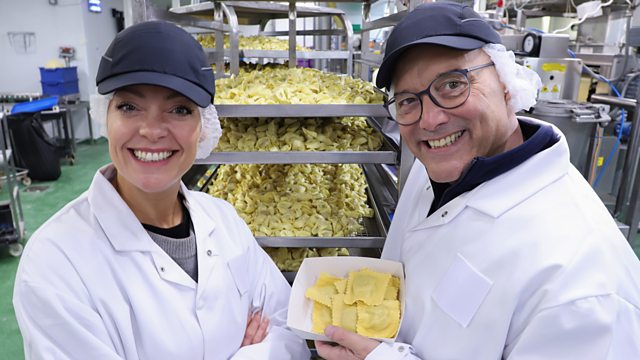
Stuffed Pasta
Gregg Wallace visits a food factory in Hertfordshire that produces 500 million parcels of stuffed pasta every year.
Gregg Wallace explores the Dell Ugo factory in Hertfordshire to reveal how it makes 500 million stuffed pasta parcels every year.
He鈥檚 following production of one of their bestsellers, crab and crayfish raviolo, and what better place to start than at the intake bay with a delivery of frozen crayfish tails. Factory manager Cesra Da Rocha explains that they receive around half a tonne a week of the freshwater crustacean, enough to make over 200,000 individual raviolo, the slightly bigger cousin of ravioli.
The delivery is wheeled over to the factory鈥檚 kitchen area, where Gregg meets one of the owners, Charlie Ugo. Charlie tells Gregg that, along with crayfish, the other key ingredient is crab. They use a mixture of both white and brown crab meat to balance out the flavours. Before the crab goes into the mixer, Gregg helps to add parsley and coriander, mayonnaise, salt and the crayfish. Then in goes the crab, followed by blue whiting, which is a fish from the same family as cod and haddock, adding a fish stock flavour and texture. Then it鈥檚 lobster stick and lemon juice, followed by some very specific mixer timings: 32 seconds in one direction, then 32 in the other. Breadcrumbs are added, and it鈥檚 all precisely mixed again.
With the filling made, it鈥檚 time for the pasta, made from special flour milled from durum wheat, which is higher in protein than traditional flour. When the flour is mixed with water, the proteins within the flour combine to form strands of gluten which turns it into dough. The more protein, the more strands are formed, and the stronger the dough will be. The factory needs a strong dough to withstand the rigorous processes used to turn it into raviolo. At this factory, they make fresh pasta dough, which requires egg. The ingredients are combined with water, but the mix is nothing like a finished dough yet; it鈥檚 too dense, so it鈥檚 sent through a specialist machine which folds and kneads it to make it stretchier, before a set of rollers creates two separate continuous sheets of pasta. After passing through two more sets of rollers, the pasta is eventually taken down to the perfect thickness for making into parcels.
With the pasta made and the filling ready, it鈥檚 time to make the raviolo with the help of another clever machine. Gregg watches on as the two pasta sheets enter a stuffed pasta-forming machine. As they pass through, 15 grams of the fishy filling are deposited at precisely spaced intervals, before the pasta is pressed together and cut out by a roller at a rate of 280 a minute. Then the stuffed pasta parcels are sent through a tunnel, where they鈥檙e blasted with steam, pasteurising them. The pasteurisation process not only kills microbial activity to extend shelf life, it also sets the gluten stands within the pasta dough, holding them in place and stabilising the shape. Then it鈥檚 a quick journey through a drier and into a giant chiller, which brings their core temperature to below four degrees Celsius.
Finally, ten raviolos are portioned into individual packs, and they head to the dispatch area, where they鈥檙e loaded into waiting lorries before being sent the length and breadth of the UK.
Elsewhere, Cherry Healey visits Cromer on the Norfolk coast to discover the traditional fishing techniques still used to catch the crab for Gregg鈥檚 stuffed pasta, and she conducts an intriguing experiment to find out if the music we listen to can affect how we taste food.
Historian Ruth Goodman learns how Italian immigrants in Bedford helped to build Britain, and she tucks into the extraordinary origins of gluten-free food.
Last on
Clip
-
![]()
"This may be the most fun I've ever had in a factory"
Duration: 01:58
Credits
| Role | Contributor |
|---|---|
| Presenter | Gregg Wallace |
| Presenter | Cherry Healey |
| Presenter | Ruth Goodman |
| Line Producer | Lena Piper |
| Series Producer | Michael Rees |
| Executive Producer | Lucy Carter |
| Executive Producer | Sanjay Singhal |
| Director | Duncan Thompson |
| Production Company | Voltage TV |
Broadcasts
- Tue 16 Jan 2024 21:00
- Sun 21 Jan 2024 18:00麻豆官网首页入口 Two except Wales & Wales HD
- Fri 2 Feb 2024 08:00
- Wed 25 Sep 2024 20:00
Learn more about the history of the factory and how it has evolved with an interactive from The Open University.
The fascinating stories behind the production of some of our favourite products.

